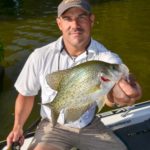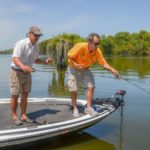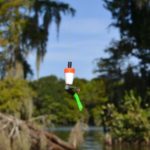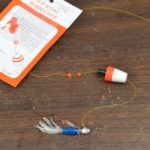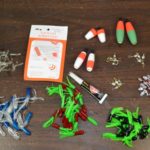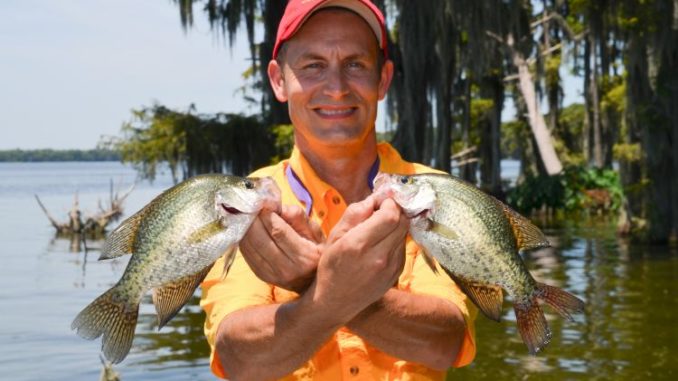
The son of renowned Louisiana angler J.B. Salter is continuing his father’s work. Here’s how to use the Salter Jiggin’ Pole to line your freezer with fish.
The cork slowly went under.
I knew it was a crappie: It didn’t swim off like a bass, twitch like a bream or disappear with a snap like a catfish.
It just eased down, down, down.
It was a Belle River crappie, aka sac-a-lait or white perch, depending on where you are from.
I was with J.B. Blaine Salter Jr., son of the legendary J.B. Salter who invented the Salter Jiggin’ Pole.
Also on the trip were Erwinville angler Jeremy Gremillion and Dave Pizzolato of Greenwell Springs.
Gremillion and Pizzolato befriended the elder Salter, who died in July 2015, and Pizzolato was our guide for the day. Both are also die-hard Salter Jiggin’ Pole addicts.
This expedition began the previous day, when I pulled into Erwinville. For both outdoorsmen and road warriors, the names Erwinville and Salter are nearly synonymous.
Before the completion of Interstate 10, Erwinville was an important pit stop on U.S. Highway 190 between Baton Rouge and Opelousas.
Salter’s Truck Stop, with its café, bar, slot machines and, yes, gasoline and diesel, was a big deal.
The town is a small place, so it wasn’t hard to find the small metal building with the sign “Salter’s Jiggin’ Pole & Tackle” off Salter Lane.
Next door sat the modest, tired, little gray home of one of Louisiana’s freshwater fishing legends.
Across the street, in a modern brick home, lived J.B.’s daughter Kelly Lejeune. Also across the street was an unhappy-looking 1979 Skeeter banana boat. It was covered in dust, the tires on the trailer were flat, and its motor was missing.
The boat had “JBSALTER fused with the boat registration numbers in the same block letters so that it looked like part of the registration.
Son Blaine met me at the shop. One corner — J.B.’s work area — was set aside almost as a museum. You could still feel his strong-willed presence on the stool beneath a hand-lettered sign reading, “Emergency Room: Dead Jigging Poles Brought Back to Life.”
The 39-year-old Salter, with grizzled-gray, spiked hair and a mischievous grin, spoke of his father in almost worshipful tones. Although he has a day job about which he is very serious (vice-president of sales for a Baton Rouge liquor company), his passion is rebuilding the Salter Jiggin’ Pole business his father deeded to him five years before his death at age 86.
“Daddy bridged the era between a cane pole and bucket of shiners or can of worms and the modern era,” he said. “With Dad’s love of fly-fishing, he saw a gap between the fly rod, the cane pole and the ultralight spinning rod.
Gremillion dropped in on us while we chatted. Although only 37, he fished three days a week with J.B. starting at the age of 12.
“During school, he would pick me up after school and we fished in the afternoon,” Gremillion said. “J.B.’s biggest impact was personal. He directed me away from the street and toward fishing.”
Salter and Gremillion, with the latter’s boat in tow, met Pizzolato with his boat at Adam’s Landing in Belle River early the next morning. The 67-year-old Pizzolato fishes sac-a-lait three days a week year-round and served as guide for the two younger men, who were unfamiliar with the area.
Pizzolato, who has fished the area since 1990, seemed to know every stick and stump in the bewildering maze of suitable-looking habitat.
First stop was in Belle River proper at the downed top of a cypress tree.
Both boats jockeyed close to the woody tangle. It was obvious their strategy wasn’t to just pick around the edges of the snag, but to go into the heart of the jungle and pull fish out of the inside.
The jig poles were ideal for that approach, something a conventional rod and reel couldn’t pull off.
“If you don’t catch a fish in 10 minutes, move,” Pizzolato explained. “I have enough spots that we can move until we find them. Trial-and-error experience are necessary to find the best spots.
“I don’t like to waste time, so I run from proven spot to proven spot.”
While Salter and Gremillion stood side by side on their boat’s bow, Pizzoloat spent most of the morning kneeling on his boat’s deck.
Of course, all three men used Salter Jiggin’ Poles. Pizzolato had his cork pegged to a fixed depth, while the two younger men used sliding corks.
Pizzolato narrated each stop for the benefit of the two younger men, explaining where the best fish-holding shelter was. The two boats, propelled by their trolling motors, danced a pirouette around each patch of cover.
The boats were so close to each other that conversation in low voices was possible. For my benefit, they compared notes on what’s important for this kind of fishing.
All three agreed the best choice in lines is Hi-Vis Golden Stren monofilament because the need to see what the line is doing is important, especially for “vertical fishing,” as one of them called tight-lining without a cork.
Any slack in the line means a fish has picked up the bait. A side-ways twitch also means a bite — even a wiggle in the line.
“It’s most critical when a fish picks a jig up while it is falling,” Gremillion said. “You can see the slack in the line with Golden Stren.”
The other thing they agreed on was that the use of stick guards, which they usually referred to as “weed guards,” allowed them to fish in dense cover. One of Pizzolato’s favorite targets is right next to the submerged root balls of cypress trees, a place impossible to fish with a bare hook.
Salter raised a point that would surprise many anglers.
“Dad said that color didn’t matter,” he said. “Contrast mattered — how far the fish could see the bait through the water. He only fished two colors of tube jigs: blue-and-clear sparkle, and black-and-lime.”
To this day Salter tackle kits are packed with black-and-lime instead of the more-often seen black-and-chartreuse because of the late J.B.’s preference.
At one stage, while the men were talking, Gremillion’s cork popped up sideways. The muscular young man socked home the jig hook on a beautiful 1/2-pounder.
“When the cork pops up and lays on its side,” he explained, “that means that a fish has picked up the jig, and with the weight of the jig not holding the cork down, it lays on its side.”
Not all strikes result in a cork submerging; some are just a subtle bump.
The swamp the men were fishing in was picture postcard-perfect, with tall cypress trees mixed with tupelo gums and an occasional gnarled live oak tree. Potential fish-holding cover was everywhere.
Some of the wood prompted Pizzolato to stop, while others didn’t. They looked the same to me, but not to him.
The veteran crappie jigger led the two boats into Four Mile Bayou, Bayou Felix and then Grassy Lake. At each stop the men twitched and bobbed their corks invitingly to entice bites on their dancing jigs.
By this stage, it had become clear that Pizzolato was focusing their fishing on downed cypress trees in 4 to 8 feet of water. The men, all experienced crappie anglers fished as close to the wood as possible.
What Pizzolato ignored was shoreline brush and cypress knees or trees in shallow water, no matter how good they looked.
Lunch hour came and went quickly.
Salter sighed loud.
“Oh, well,” he said, a signal that he hadn’t forgotten a promise to his wife to make it home in time for a wedding.
The three conferred briefly, and when Salter and Gremillion turned the boat for home, Pizzolato grinned broadly and waved as he jumped his boat up on a step to head farther into the swamp.
He didn’t have a wedding to go to.

